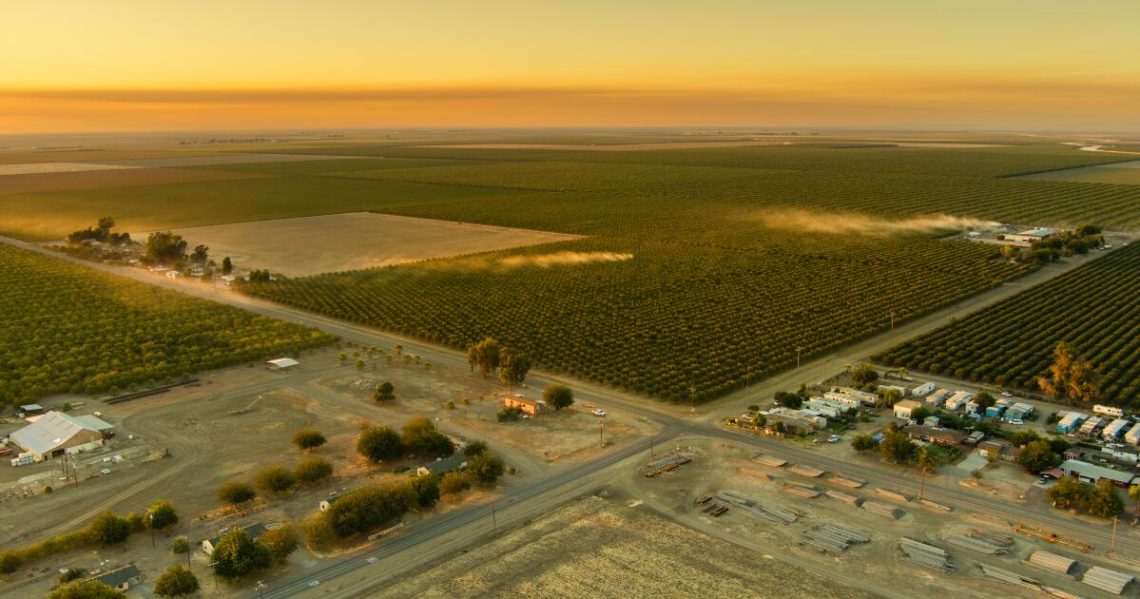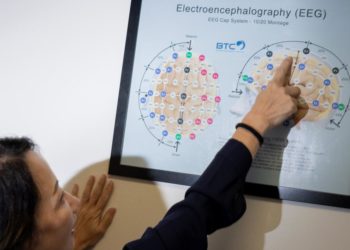CANTUA CREEK, Calif. — The fallowed farmland — too dry, salty and barren to grow crops — stretches across a remote, sunbaked expanse crisscrossed by rutted dirt roads.
Soon, roughly 15 square miles of these retired agricultural fields in western Fresno County will hold one of the world’s largest solar and battery energy storage projects — a behemoth capable of powering some 850,000 homes for four hours.
The Darden Clean Energy Project, approved by the California Energy Commission in June, is the first development to be fast-tracked under a 2022 state law that allows large renewable energy projects to be reviewed and permitted without sign-off from county and municipal governments.
The Opt-In Certification Program, as it is called, is meant to sidestep the kind of local pushback that can drag on for years. And the Darden project’s approval was touted by Gov. Gavin Newsom as a major victory in helping the state meet its ambitious climate goal of using 100% clean energy by 2045.
But in rural western Fresno County — where energy firms have planned multiple large-scale battery and solar projects — many residents feel blindsided. They have raised serious questions about who benefits and who gets left behind when major projects are fast-tracked.
Espi Sandoval, a board member for the nonprofit Rural Communities Rising, a western Fresno County advocacy group, said the impoverished, mostly Latino area has long been exploited by corporate agriculture and now is playing catch-up as it finds itself suddenly at the forefront of California’s energy transition.
“We’re forgotten by the government. Now we’ve got this private sector coming in with these huge solar panel farms,” said Sandoval, who has lived in western Fresno County since 1972. “I don’t want to see the same exploitation of our people.”
Within a few miles of the Darden site are several tiny farmworker towns, including Cantua Creek, Five Points and Three Rocks (also known as El Porvenir). The solar and lithium-ion battery project will be built within a census tract where more than a third of residents live in poverty — double the rate in Fresno County as a whole.
The nearby towns struggle with poor drinking water and air quality, extreme heat and lack of access to opportunity, dozens of environmental justice groups and community advocates wrote in a letter to Newsom and the Energy Commission as the project was being considered.
In its oversight of the Darden project, they wrote, the state “has the potential to either set the stage for an equitable, just transition or, conversely, to continue patterns of disinvestment in low-income communities of color.”
The Darden project’s owner, IP Darden I, a subsidiary of San Francisco-based Intersect Power, is set to become the second-largest property tax payer in Fresno County, behind Pacific Gas and Electric. Intersect will pay at least $232 million to the county over the next decade, according to an economic impact report by the company.
The project also is projected to generate tens of millions of dollars in local sales tax, including through the purchase of construction equipment and materials, according to Intersect Power. The company said it will create more than 1,200 construction jobs while it is being built and 16 full-time operational jobs once it’s up and running.
Maria Pacheco, the mayor of Kerman, a small city northeast of the Darden site, wrote in a letter to the Energy Commission this spring that the project’s jobs and tax revenue will be transformative for the San Joaquin Valley. They will help provide “essential services and infrastructure improvements, directly benefiting the often-underserved west side,” she wrote.
The stakes are big near Darden, including for Newsom’s plans to expedite other clean energy projects. The Opt-In Certification Program requires environmental reviews to be completed within 270 days of a project application being deemed complete.
Eight other projects, from Imperial County in the south to Shasta County in the north, currently are pursuing approval through the opt-in process. And after significant local pushback, a developer that has been planning to build a lithium-ion battery storage facility on the site where Morro Bay’s iconic smokestacks stand pulled out of the municipal permitting process this spring, indicating it might pursue the state’s fast-track program.
As part of the fast-track process, Intersect Power was required to enter into at least one so-called “community benefits agreement” with a local organization and to provide tangible benefits to the region.
Intersect Power agreed to donate $2 million to local groups over the next 10 years and $5 million over the life of the project.
In a statement to The Times, Elizabeth Knowles, the head of community engagement for Intersect, said the company has been meeting with residents, schools and other local stakeholders since 2023. Intersect’s community benefits spending, she said, is “going directly to highly reputable nonprofits” and community-based organizations that will focus on western Fresno County.
Much of the initial $2 million will be split among Fresno-based nonprofits that work to build housing and reduce asthma and hunger. An Intersect donation to the nonprofit Centro la Familia Advocacy Services was used to give away 250 high-efficiency window air-conditioning units to households close to the Darden site this summer.
The company also agreed to give money to Westside Elementary School, about four miles southeast of the site, to support campus upgrades and efforts to build more local housing.
Some donations have raised eyebrows. An undisclosed amount of the Intersect Power donations also will fund two years of after-school piano lessons from the Steinway Piano Gallery of Fresno at Cantua Elementary School.
In an email to The Times, Felipe Piedra, superintendent of the Golden Plains Unified School District, which includes Cantua Elementary, said 98% of the school’s roughly 185 students qualify for free or reduced lunch and “are in need of additional support and resources.” He said “water and clean energy are a big priority” but did not answer questions about why funds were going toward piano lessons.
Intersect Power is donating an undisclosed amount to the nonprofit Tree Fresno, which plants shade trees to reduce the effects of extreme heat and air pollution.
Sandoval, a former member of the Kerman City Council and longtime teacher in nearby Tranquility, scoffed at the piano lessons and tree donation, noting that Cantua Elementary is across the street from an orchard. He said he was frustrated to see Intersect Power working primarily with Fresno-based nonprofits.
“This thing is dictated from the top,” he said. “How is the money going to filter down to the community? Property taxes? That’s going to the county. How can we get some of those benefits?”
In an email to The Times, Tree Fresno’s chief executive, Mona Cummings, said her organization was assessing the need for plantings at the elementary schools in Cantua Creek and Five Points and seeking more input from locals.
During a public meeting in Coalinga this April, Leticia Villegas, a farmworker from Five Points, told the Energy Commission that she lives three miles from where the Darden solar panels will be built. She said through a Spanish interpreter that she works in fields during the day, when the sun is baking, and comes back to a run-down home with no air conditioning.
She said she hopes money from the development will “go directly to our community.”
“Please,” she added, “we want to be listened to.”
Felipe Perez, a City Council member in nearby Firebaugh and a former fieldworker, said he used to pick crops near the Darden site. He said it was not easy seeing new industries arrive, “using soil that we used to use for ag.”
Perez, 56, who came to the U.S. from Sinaloa, Mexico, in 1988, said there are not as many field jobs as there once were, in part because of drought and out-of-town farmers selling their land.
“The question is, are they going to hire us?” he said of clean energy developers. “In what language are they going to teach us? And what are we going to do when they don’t help us and we still get those kind of bills?”
Construction on the Darden project is expected to begin by the end of this year, and it should be fully operational in late 2027 or early 2028, Knowles said.
It will be built on 9,500 acres sold by the Westlands Water District, the nation’s largest agricultural water district. Decades of farming and irrigation have degraded the soil, drawing salts and metals to the surface. That and the district’s uncertain water supplies have made the land impractical for farming, prompting Westlands to divert water to more productive land.
The Darden project — located near a major PG&E power line that can transmit electricity north or south — will include a 1,150-megawatt solar facility with approximately 3.1 million solar panels.
It also will have up to 1,150 megawatts of battery storage via 1,440 Tesla Megapack 2XL units — essentially shipping container-sized units filled with battery modules. Such battery systems store excess energy generated during the day and release it into the power grid during times of high demand, including evening hours.
But in western Fresno County, many residents have expressed concern about the lithium-ion batteries catching fire — a fear that intensified after a massive blaze in January tore through a battery energy storage system in Moss Landing, a rural community in coastal Monterey County.
That fire, which burned more than 54,000 LG battery modules, spewed toxic smoke into the air and smoldered for several days. Firefighters let it burn, citing the dangers of dousing lithium-ion battery fires with water, which can cause dangerous chemical reactions. The risk of reignition has been so high that cleanup crews are just now beginning to remove the charred batteries.
Knowles said the Darden site will be safer because batteries will be in independent enclosures separated by open space outdoors, not stacked and placed in an enclosed building like they were in Moss Landing.
With proper engineering, lithium-ion battery storage sites pose little risk of catching fire, said Shirley Meng, a molecular engineering professor at the University of Chicago who is an expert on batteries and studies ethically sourced, recyclable materials for energy storage. Safety has improved dramatically in recent years, and the failure rate is about 1 in 10 million for all types of lithium-ion batteries, she said.
“Everybody has batteries in their hands,” Meng said, referencing smartphones. “Batteries are safe. The chemistry that’s in those [large-scale] facilities is even safer than the ones that you hold in your phone.”
In western Fresno County, residents have “been very vocal” about the Darden project being built in a place where emergency response times are already long, said Ryan Michaels, assistant chief of operations for the Fresno County Fire Protection District, which provides emergency services for the area.
There is no fire station in the nearest communities of Cantua Creek, Five Points and Three Rocks. Response time is typically more than 20 minutes, and “we want to make sure that as solar grows we don’t reduce our current level of services within those communities,” Michaels said.
Several large solar farms already have been built and are planned, and “it really hit us by surprise how many were coming to western Fresno County,” he added.
In recent months, Michaels said, firefighters have responded to numerous malfunctioning alarms and inverter fires at solar farms, he said. One recent blaze was sparked by vandals trying to steal wiring.
Intersect Power and the Fresno County Fire Protection District said they are still negotiating fire mitigation measures. A state-required emergency action plan has not yet been finalized.
Stacey Shepard, a spokesperson for the California Energy Commission, said Darden, like all such projects, must meet strict safety standards. When batteries are being shipped from the factory to the project site, they can only be charged up to 30%, and the developer has to provide at least two gates into the battery storage facility wide enough for emergency access. On site, she noted, the batteries will be surrounded by thermal detection cameras.
Even so, the fire protection district said it will need to build four new stations and hire additional staff as more large clean energy projects are built.
Michaels said Darden and other projects have to be planned for the long term. If it is going to be operating for up to 35 years, he said, “we need to be ready to fight fire there — and provide for their workers — for decades.”
This article is part of The Times’ equity reporting initiative, funded by the James Irvine Foundation, exploring the challenges facing low-income workers and the efforts being made to address California’s economic divide.
The post Permits were expedited for this California clean energy project. Were residents sidelined? appeared first on Los Angeles Times.




